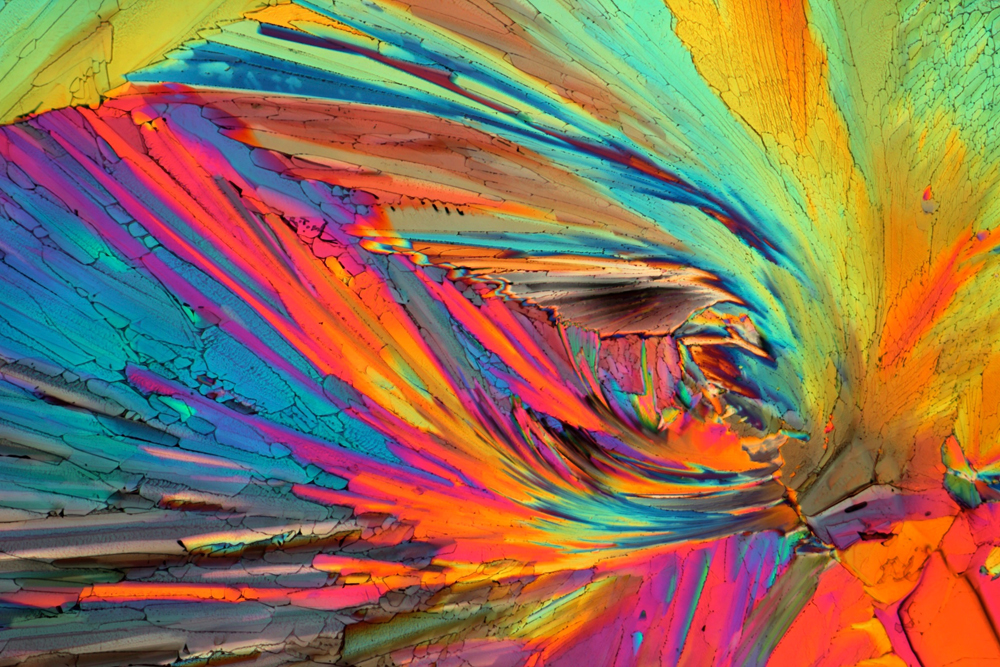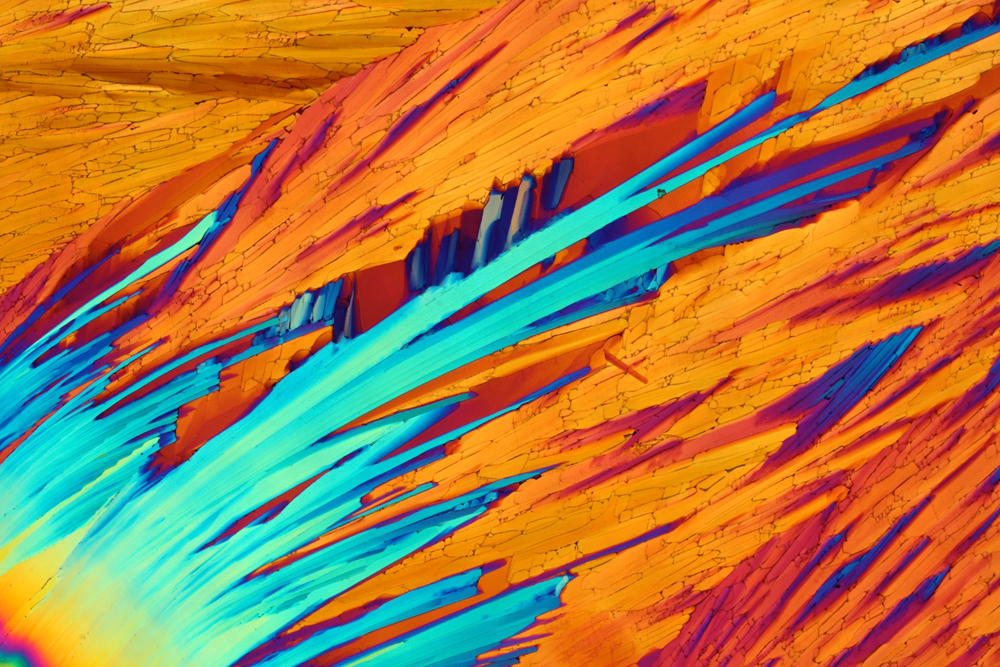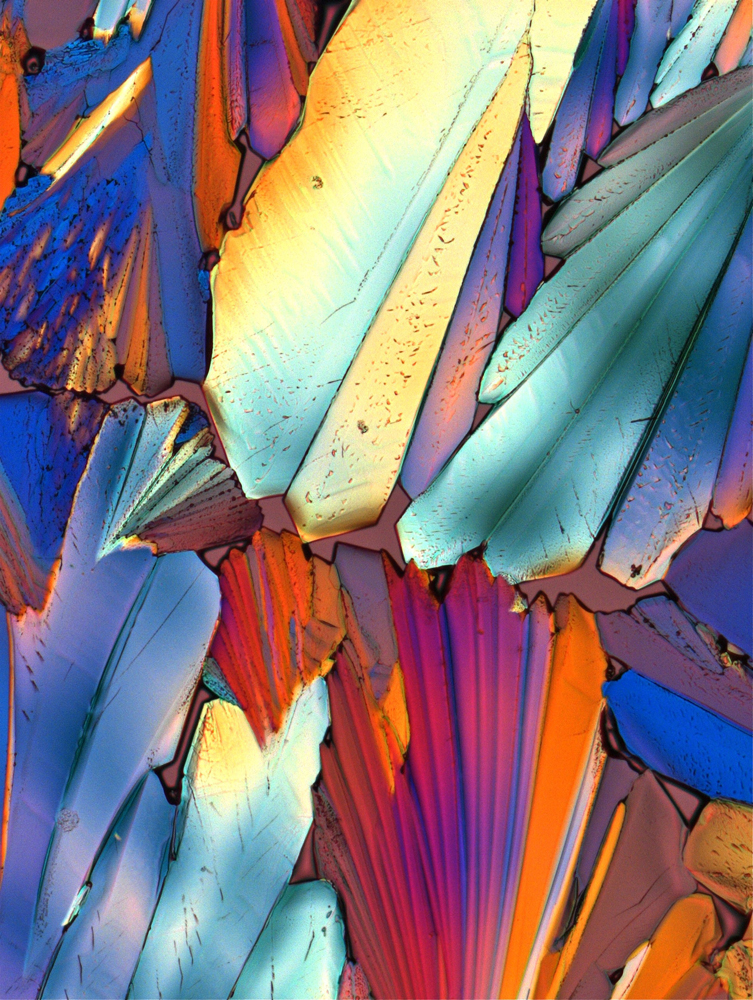Salute! Stunning Microphotos Capture Boozy Beauty in Italian Cocktails

The images look like the feathers of some exotic bird, or perhaps close-ups of brilliantly cut gems. But what are they, really?
Italian cocktails.
A new series of photographs taken using microscopy highlights the beauty in boozy beverages with just a trick of the light. The images are created (without Photoshop) by Italian geologist Bernardo Cesare, who has long used light microscopes and polarizing filters to study the mineral structures in rocks. [See Amazing Microscopic Photos of Italian Cocktails]
Now, Cesare has turned to photographing alcoholic drinks, capturing the sugars that crystalize as drops of the drink dry. The technique is the same as working with rocks, though it requires more patience, he said; whereas rocks can be sliced into thin sections relatively quickly, a drop of drink can take weeks to dry.
Live Science talked with Cesare about snapping micro-photos of his mother-in-law's homemade limoncello and why rocks will always be his favorite subject. (This Q&A has been edited for length and clarity.)
Live Science: How does this photographic technique work, and what do the resulting images show?
Bernardo Cesare: The technique is called transmitted polarized light microscopy. It can sound complicated but simply means that we observe, under an optical microscope, something which light passes through, and that this light is polarized. The light bulb is below the sample, at the base of the microscope. The sample needs to be transparent to light. Before hitting the sample, the light passes through a polarizing filter, like the lens of sunglasses.
Get the world’s most fascinating discoveries delivered straight to your inbox.
Then, using another polarizer above the sample, we can disclose the colors, called "inference colors" that pervade these micrographs. Note that the polarizers are colorless!
Understanding the formation of interference colors is quite complicated. Let us just say that these colors are the result of the propagation of polarized light into crystalline matter and that the color depends on the nature of the solid, on its thickness, and on the orientation of its crystal structure with respect to the polarized light.
Using this technique — routine for a geologist — we can capture small areas of [a] specimen, from a few millimeters to less than a millimeter across, and show its internal constitution. Patches of different colors represent different crystals.
Polarizing microscopy is a scientific tool that helps [scientists] understand the mineralogical composition and geological history of a rock. As a geologist, I have been practicing it for 30 years. At the same time, I have developed a parallel interest for aesthetic photomicroscopy, where I play with the polarized light, not with Photoshop, in order to obtain appealing combinations of interference colors and shapes — something at the intersection of science and art. [Research as Art: A Gallery of Scientific Beauty]
Live Science: What equipment do you use in making these images?
Cesare: A polarizing microscope. The quality of optics is essential for the final result, as is a good subject. The camera without a lens is attached on top of the microscope, as the microscope objective is now the lens. The adapter that connects the camera to the microscope must be of high quality in order not to lose resolution and be able to capture the smallest details.
The sample is also special. In order to be transparent and be passed through by the polarized light, it has to be thin. Rocks are thinned down to 0.03 millimeters (30 microns!) [or about 0.0012 inches], whereas crystallized drinks can reach a thickness of a few hundred microns. [For comparison, the average human hair measures about 100 microns wide.] This raises some challenges for the focusing of the subject, as the depth of field in photomicroscopy is almost zero.
Both rocks and drops of drink are, of course, glued or placed on a transparent glass slide so that the subject is as flat as possible.
Live Science: Obviously, you've been doing this with rocks for some time. How did you decide to start trying it with drinks?
Cesare: Just for fun. I had come to know the late Michael Davidson, the undisputed guruof photomicroscopy, and his stunning micrographs of drinks (the BevShots project). But I never wanted to try and shoot drinks because I believe my artistic niche is that of rocks and minerals, and I didn't want to copy from others' work.
But one day, I was inspired by a colleague who, after watching Davidson's micrographs of beer and cocktails, told me, "You should try with Spritz." Spritz is a Venetian aperitif made with seltzer, white wine and another liqueur. So, looking for an approach that wouldn't replicate Davidson's unbeatable artwork, I decided to take photomicrographs of Italian drinks, starting with Aperol and bitter Campari. I added also the excellent limoncello homemade by my mother-in-law.
The idea is simple: to place a drop or a thin layer of the drink on a glass slide and to leave it there until it crystallizes. What actually happens is that the alcohol and water of the drinks dry, and their sugars crystallize. [Raise Your Glass: 10 Intoxicating Beer Facts]
Crystallizing drinks is tricky, because they can be unpredictable. The first attempt I made was with small drops of Aperol placed on a glass slide. Nothing happened for more than a month, and then, suddenly, crystallization was completed in about a day. This behavior is no surprise to anyone involved in the kinetics of nucleation and growth of natural or synthetic crystals from solutions. It has to do with the degree of supersaturation that has to be reached before crystals start to form.
Live Science: What makes these patterns in the drink images? How do the brilliant colors emerge?
Cesare: In the portfolio of drinks, some images show stripes of color, radiating or parallel; some others show more geometric patches; others show tree- or branch-like shapes. Regardless of the shape and color, each patch is a crystal of sugar (sucrose C12H22O11). Differences in shape identify different textures that reflect different ways (nucleation, speed, direction, etc.) the crystals grew.
A typical pattern of crystallized drinks is the radial texture of sugar crystals. It is apparent in several images by the arrangement of color patches in thin stripes that converge toward a center, like petals of a flower, and display a symmetrical distribution of colors. It derives from a fast crystallization starting from a single point. Differences in colors are related to a different orientation of the crystals or to differences in thickness, such as for the limoncello micrographs.
The photos demonstrate that the same substance, with the same thickness, can display different interference colors depending on its orientation with respect to the polarized light.
Live Science: What other materials work well for this technique? Are there materials you've tried that don't create very interesting images?
Cesare: I must admit that the best materials are rocks because of their variety of minerals and textures that reflect the variety of natural geological processes. [Photos: The World's 6 Most Famous Rocks]
Other photogenic materials are simple pieces of plastic film. When stretched and broken, they can provide gorgeous images.
There are materials which do not perform well, or which were disappointing. Some rocks, for example, may be beautiful as hand specimens but bad for microscopy because [the] crystals are too big or too weathered, or because their optical properties do not work well. This is particularly true for carbonates, like calcite and dolomite, the main components of many sedimentary rocks, which quite often provide dull, monotone images.
Speaking of drinks, I failed with red wine, from which I didn't obtain satisfactory micrographs. I know it is possible because Davidson shot gorgeous BevShots from wine and beer, but I wasn't able to imitate him.
Live Science: What's the biggest challenge in creating these images?
Cesare: The biggest challenge for me with drinks is simply being able to crystallize them! And to do it on a flat surface. As I said before, in some cases, crystallization can take a month. In others, it can take forever! Some drinks with low sugar content are particularly difficult, if not impossible, to work with.
Live Science: Do you have plans to experiment with new materials? What would you like to try next?
Cesare: I want primarily to stick to rocks. There's so much to discover with them. In addition, they're natural, and there's no intervention by the photographer in the construction of shapes and textures. I would like to do something with chondrites, a type of meteorite, because they have a great aesthetic potential.
There are a few projects going on, which are a kind of experiment for me. One is about dolomitic rocks. I have noted above that shooting carbonate sedimentary rocks for [an] aesthetic purpose is challenging. However, with friends, we've tried, and succeeded, in building a project (DolomitiArtRock) that is not only artistic but also educational, and that will expand in the next few years.
The second is on agates. These rocks are stunning both at the macro and at the micro scale of observation. I am collaborating with my micrographs to an encyclopedic book on Lake Superior agate. And I would like to partner with another photographer, specialized in macrophotography, for a book on agates, micro and macro.
Finally, on the drinks side, I have promised I will try another popular Italian cocktail: Bellini.
Original article on Live Science.

Stephanie Pappas is a contributing writer for Live Science, covering topics ranging from geoscience to archaeology to the human brain and behavior. She was previously a senior writer for Live Science but is now a freelancer based in Denver, Colorado, and regularly contributes to Scientific American and The Monitor, the monthly magazine of the American Psychological Association. Stephanie received a bachelor's degree in psychology from the University of South Carolina and a graduate certificate in science communication from the University of California, Santa Cruz.





